Uncategorized
The U.S. is lacking a key aspect of any recession

This story was originally published on TKer.com.
When we were younger, there was a point when someone told us that a recession was defined as two consecutive quarters of negative GDP growth, as measured by the Bureau of Economic Analysis (BEA).
Later, some of us learned that a recession is in fact designated and dated by the National Bureau of Economic Research (NBER), who make the call when they see a “significant decline in economic activity that is spread across the economy and that lasts more than a few months.” The variables the bureau emphasizes include income, employment, personal consumption, and industrial production.1
If there’s any doubt that it’s the NBER who’s behind official recession calls, then consider this statement from the BEA:
While gross domestic product (GDP) is the broadest measure of economic activity, the often-cited identification of a recession with two consecutive quarters of negative GDP growth is not an official designation. The designation of a recession is the province of a committee of experts at the National Bureau of Economic Research (NBER), a private non-profit research organization that focuses on understanding the U.S. economy.
So there you have it.
That said, this exercise of defining recessions isn’t very productive. It’s mostly just semantics, and it’s highly dependent on the metrics you decide to include and exclude in how you calculate economic activity.²

One thing everyone can agree on is that much of the economy is slowing. In fact, the BEA says GDP contracted at a 1.6% rate in Q1, and the Atlanta Fed’s GDPNow model is pointing to a 1.2% contraction in Q2.
But some very visible aspects of the economy are holding up very well.
Jobs growth? In this economy?
While there have been signs the jobs market has been cooling, it certainly does not reflect an economic recession.
According to Bureau of Labor Statistics (BLS) data released Friday, U.S. employers in June added a healthy 372,000, which was considerably stronger than the 265,000 expected by economists.
Total employment stood at 151.980 million, which is up 21.467 million from its low in April 2020. It’s now just barely below its pre-pandemic level of 152.504 million in February 2020.

So while the stock market has tumbled and economic activity has decelerated since the beginning of the year, the labor market has added 2.74 million jobs during the same period with gains in every month.
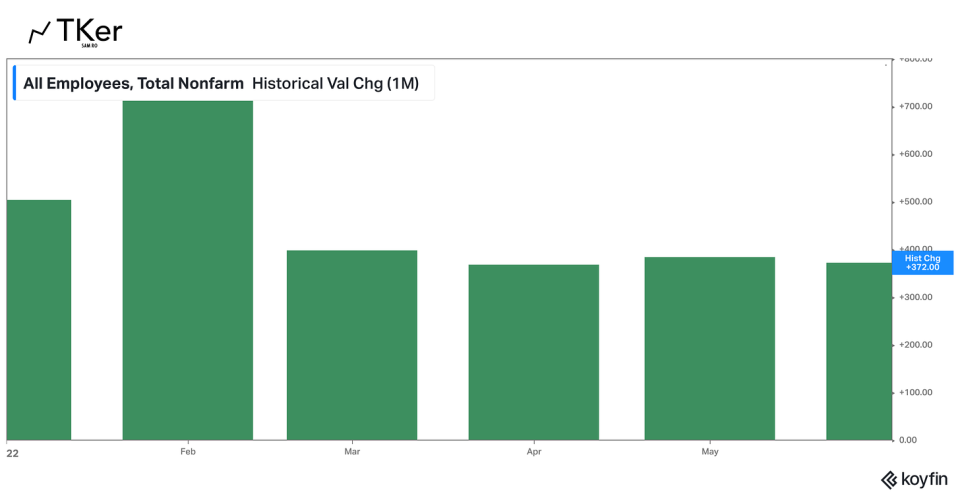
Also, the unemployment rate remains very low at 3.6%.
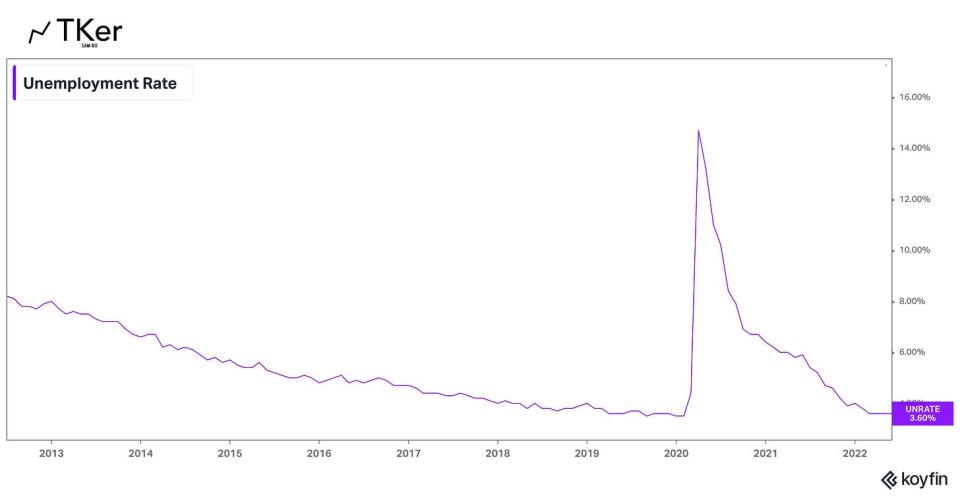
This is in line with BLS data released on Wednesday that showed the layoff rate remained near a record low of 0.9% in May.
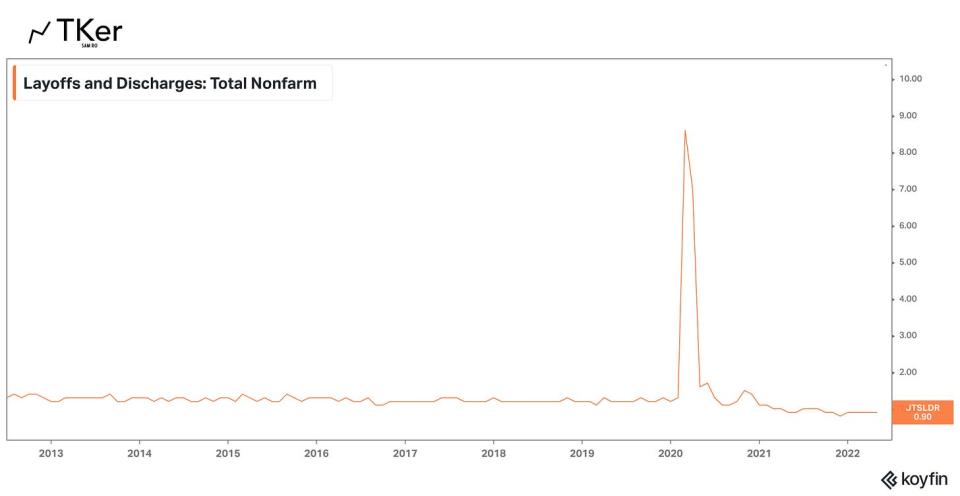
The more timely unemployment claims data also suggests the jobs market is in pretty good shape.
Initial claims for unemployment insurance came in at 235,000 for the week ending July 2. While the number is up from its six-decade low of 166,000 in March, it remains near levels seen during periods of economic expansion.
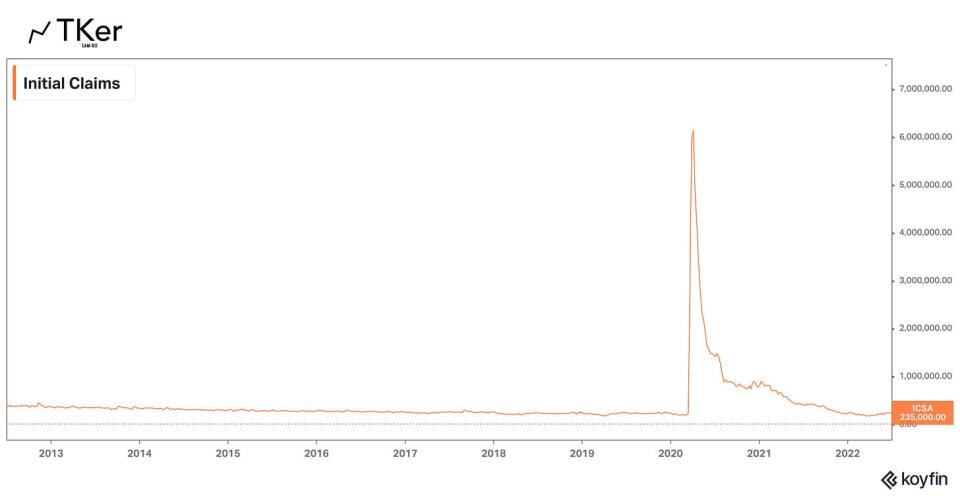
“If the economy is in a recession, employers have not seemed to notice,“ Wells Fargo economists wrote on Friday.
So far, we’ve been looking at labor market metrics that reflect the past and the present. But what about the future?
Based on job openings data, it’s pretty clear that the demand for more labor continues to be very strong.
According to BLS data released Wednesday, there was a whopping 11.25 million job openings in May. That compares to the 5.95 million unemployed during the same period.

With nearly two job openings per unemployed person, this is a very tight labor market with a lot of demand for workers.
Why this is not a recession
“In recent decades, the two measures we have put the most weight on are real personal income less transfers and nonfarm payroll employment,” the NBER explained regarding its recession calls.
Indeed, according to Deutsche Bank’s analysis of recessions since 1939, the first month of a recession on average sees a decline in jobs. And we haven’t seen a decline in jobs since December 2020.

Regarding real personal income less transfers, that metric also continues be very strong. According to BEA data released June 30, it climbed to a record annualized rate of $14.5 trillion in May.

The BLS also has a metric called the index of aggregate weekly payrolls, which is the product of jobs, wages, and hours worked. It’s a rough proxy for the total nominal spending capacity of the workforce. This metric increased by 0.6% month-over-month in June to a record high of 172.4, reflecting a 9.4% jump from a year ago. Before the pandemic, the annual growth rate was trending at around 5%.

When incomes are rising, so is the capacity to spend. And consumers are spending.
Strong jobs data is good. However…
These labor market trends are obviously good news for those getting new jobs as well as those who aren’t getting laid off.
However, there is the risk that this good news and the incremental consumer demand that comes with it puts pressure on the supply chain, which would be inflationary. And that’s bad news as the Federal Reserve’s top priority right now is to bring down inflation, even if it means employing tight monetary policy that does some serious damage to economic activity.
On an encouraging note regarding inflationary pressures, average hourly earnings in June increased by just 0.3% from May. This reflects a 5.1% gain from a year ago, which is down from 5.3% in May, 5.4% in April, and 5.6% in March.³

While the level of job openings remains very high, it has been declining from its March high of 11.9 million. This should further help ease wage pressures, and in turn inflation should come down.
That said, we seem to be a long way from getting “clear and convincing” evidence sought by the Fed that inflation is on its way lower. And until we get that evidence, expect the Fed to continue to tap the brakes on the economy.
For now, the strong labor market is keeping the economy from tipping into a recession. But the longer the Fed has to tighten monetary policy aggressively, the more likely it becomes that people start to lose jobs as part of the economic pain required to rein in prices.
–
Related from TKer:
Recap 📋: For a little over a year, the rapid economic recovery came with demand growth sharply outpace supply, causing inflation rates to rise. However, supply has failed to catch up, which is why the Federal Reserve has been tightening monetary policy in an effort to bring down inflation by cooling demand. While economic growth has indeed been slowing in recent months, high inflation persists. And now we have an even more hawkish Fed putting even more pressure on the economy, and it’s doing so by targeting the financial markets.
Last week 🪞
📈 Stocks climb: The S&P 500 rose 1.9% last week to close at 3,899.38. The index is now down 18.7% from its January 3 closing high of 4,796.56 and up 6.3% from its June 16 closing low of 3,666.77. For more on market volatility, read this and this. If you wanna read up on bear markets, read this and this.
As I wrote last month, it appears that the markets will be held hostage by the Fed as long as inflation isn’t showing “clear and convincing” signs of easing. Read more about this here and here.
⛓ Supply chains are loosening: The New York Fed’s Global Supply Chain Pressure Index4 fell in June to its lowest level since March 2021, meaning supply chains are loosening.
It’s also a busy week for economic data. Wednesday comes with the June consumer price index report, followed by the June producer price index report on Thursday. On Friday, we’ll get the June retail sales report, June industrial production report, and the preliminary July consumer sentiment survey results from the University of Michigan.
1. The NBER defines a recession as “a significant decline in economic activity that is spread across the economy and that lasts more than a few months. The committee’s view is that while each of the three criteria—depth, diffusion, and duration—needs to be met individually to some degree, extreme conditions revealed by one criterion may partially offset weaker indications from another… The determination of the months of peaks and troughs is based on a range of monthly measures of aggregate real economic activity published by the federal statistical agencies. These include real personal income less transfers (PILT), nonfarm payroll employment, real personal consumption expenditures, wholesale-retail sales adjusted for price changes, employment as measured by the household survey, and industrial production. There is no fixed rule about what measures contribute information to the process or how they are weighted in our decisions.”
2. One widely known criticism of the GDP calculation is that net imports are a negative. In other words, if the U.S. economy is relatively stronger than international economies and that’s causing imports to outpace exports, then GDP suffers.
3. Fed chair Jerome Powell argued that one of the main forces driving up inflation was rising wages. The theory is that higher wages enable businesses to raise prices. If wages aren’t rising, then consumers wouldn’t be able to pay up for higher prices, which leads to a combination of demand cooling and prices coming down.
4. Here’s some info on how the index is constructed according to the NY Fed: “We use the following subcomponents of the country-specific manufacturing PMIs: ‘delivery time,’ which captures the extent to which supply chain delays in the economy impact producers—a variable that may be viewed as identifying a purely supply-side constraint; ‘backlogs,’ which quantifies the volume of orders that firms have received but have yet to either start working on or complete; and, finally, ‘purchased stocks,’ which measures the extent of inventory accumulation by firms in the economy. Note that in case of the U.S., the PMI data start only in 2007, so for the U.S. we combine the PMI data with those from the manufacturing survey of the Institute for Supply Management (ISM).“
This story was originally published on TKer.com.
Sam Ro is the founder of Tk.co. Follow him on Twitter at @SamRo.
Click here for the latest stock market news and in-depth analysis, including events that move stocks
Read the latest financial and business news from Yahoo Finance
Download the Yahoo Finance app for Apple or Android
Follow Yahoo Finance on Twitter, Facebook, Instagram, Flipboard, LinkedIn, and YouTube
Uncategorized
BofA Securities maintains Amazon.com at ‘buy’ with a price target of $154.00
Uncategorized
Six people in critical condition, one still missing after Paris blast – prosecutor

5/5
© Reuters. French firefighters and rescue forces work after several buildings on fire following a gas explosion in the fifth arrondissement of Paris, France, June 21, 2023. REUTERS/Gonzalo Fuentes
2/5
PARIS (Reuters) – Six people remained in a critical condition and one person was believed still missing on Thursday, one day after a blast ripped through a street near Paris’ historic Latin Quarter, the city’s public prosecution office said. “These figures may still change,” prosecutor Maylis De Roeck told Reuters in a text message, adding that around 50 people had been injured in the blast, which set buildings ablaze and caused the front of one to collapse onto the street. Of two people initially believed missing, one has been found in hospital and is being taken care of, the prosecutor said, adding: “Searches are ongoing to find the second person.” Authorities have not yet said what caused the explosion, which witnesses said had followed a strong smell of gas at the site. The explosion led to scenes of chaos and destruction in the historic Rue Saint Jacques, which runs from the Notre-Dame de Paris Cathedral to the Sorbonne University, just as people were heading home from work. It also destroyed the facade of a building housing the Paris American Academy design school popular with foreign students. Florence Berthout, mayor of the Paris district where the blast occurred, said 12 students who should have been in the academy’s classrooms at the time had fortunately gone to visit an exhibition with their teacher.
“Otherwise the (death toll) could have been absolutely horrific,” Berthout told BFM TV. She said three children who had been passing by at the time were among the injured, although their lives were not in danger.
Uncategorized
4 big analyst cuts: Alcoa & DigitalOcean shares drop on downgrades
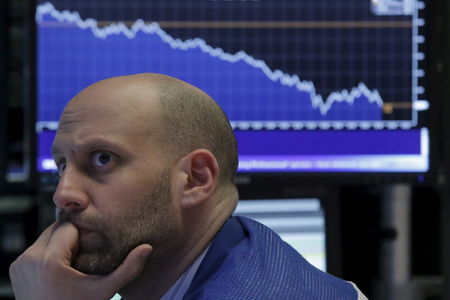
© Reuters.
Here is your Pro Recap of the biggest analyst cuts you may have missed since yesterday: downgrades at Alcoa, DigitalOcean, Teleflex, and Xcel Energy.InvestingPro subscribers got this news in rapid fire. Never be left in the dust again.Alcoa stock drops on Morgan Stanley downgrade Alcoa (NYSE:) shares fell more than 3% pre-market today after Morgan Stanley downgraded the company to Underweight from Equalweight and cut its price target to $33.00 from $43.00, as reported in real time on InvestingPro.The firm sees a significant decline in consensus estimates, and as negative earnings revisions materialize, it believes the stock will face downward pressure and underperform.The analyst’s estimates for EBITDA in Q2, 2023, and 2024 are substantially lower than the consensus. The stock is currently trading above its historical average. The firm said its downward revisions in earnings estimates and price target are attributed to the company’s high operating leverage to aluminum prices.DigitalOcean stock plunges on downgradePiper Sandler downgraded DigitalOcean (NYSE:) to Underweight from Neutral with a price target of $35.00. As a result, shares plunged more than 5% pre-market today.The company reported its last month, with revenue beating the consensus estimate, while EPS coming in worse than expected. Furthermore, the company provided a strong outlook, which was above the Street estimates.2 more downgradesTeleflex (NYSE:) shares fell more than 3% yesterday after Needham downgraded the company to Hold from Buy, noting that UroLift expectations may still be too high.According to Needham, their checks indicate that urologists are reducing their use of UroLift due to its retreatment rates, reimbursement cuts, and increasing use of competing procedures. This is also supported by their Google Trends data analysis, which indicates decreasing search interest in UroLift.BMO Capital downgraded Xcel Energy (NASDAQ:) to Market Perform from Outperform and cut its price target to $64.00 from $69.00 to reflect the lower-than-expected terms of the company’s regulatory settlement in Colorado.Amid whipsaw markets and a slew of critical headlines, seize on the right timing to protect your profits: Always be the first to know with InvestingPro.Start your free 7-day trial now.

 Forex3 years ago
Forex3 years agoForex Today: the dollar is gaining strength amid gloomy sentiment at the start of the Fed’s week

 Forex3 years ago
Forex3 years agoUnbiased review of Pocket Option broker

 Forex3 years ago
Forex3 years agoDollar to pound sterling exchange rate today: Pound plummeted to its lowest since 1985

 Forex3 years ago
Forex3 years agoHow is the Australian dollar doing today?

 Cryptocurrency3 years ago
Cryptocurrency3 years agoWhat happened in the crypto market – current events today

 World3 years ago
World3 years agoWhy are modern video games an art form?

 Commodities3 years ago
Commodities3 years agoCopper continues to fall in price on expectations of lower demand in China

 Economy3 years ago
Economy3 years agoCrude oil tankers double in price due to EU anti-Russian sanctions


























